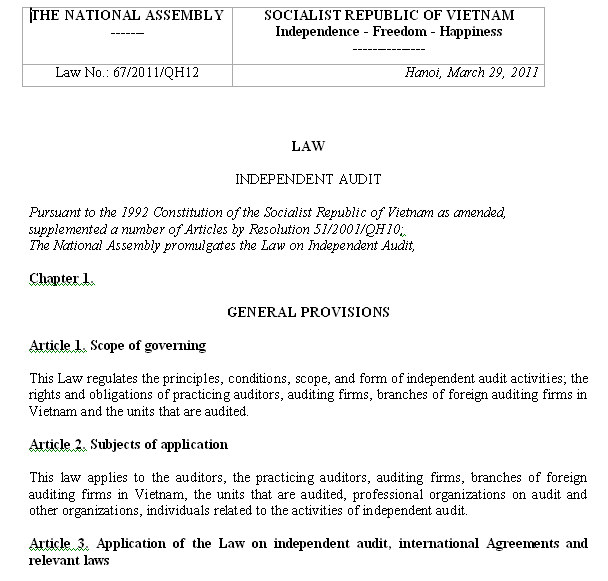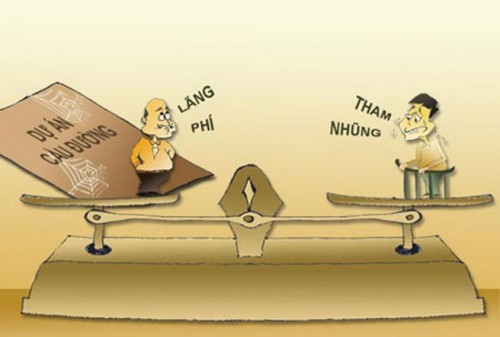| THE GOVERNMENT ——- |
SOCIALIST REPUBLIC OF VIET NAM Independence – Freedom – Happiness ———- |
| No. 118/2016/ND-CP | Hanoi, July 22nd 2016 |
DECREE
STIPULATING THE ORGANIZATION AND OPERATION OF TISSUE BANKS AND THE NATIONAL COORDINATION CENTER FOR HUMAN ORGAN TRANSPLANTATION
THE GOVERNMENT
Pursuant to the December 25, 2001 Law on Organization of the Government;
Pursuant to the November 29, 2006 Law on Donation. Removal and Transplantation of Human Tissues and Organs and Donation and Recovery of Cadavers;
At the proposal of the Minister of Health,
DECREES:
Chapter I
TISSUE BANKS
Section 1. ESTABLISHMENT OF TISSUE BANKS
Article 1. Legal status, functions and tasks of tissue banks
Tissue banks have the legal status, functions and tasks stipulated in Clauses 1,2 and 5, Article 35 of the Law on Donation, Removal and Transplantation of Human Tissues and Organs and Donation and Recovery of Cadavers;
Article 2. Types of tissue banks
Tissue banks are medical facilities that are organized under one of two following forms:
- Tissue banks that are affiliated to State-owned or private medical facilities, Medical Universities, Universities of Medicine and Pharmacy or National Coordination Center for Human Organ Transplantation (hereinafter referred to as “affiliated tissue bank”)
- State-owned or private tissue banks that are independent from other organizations (hereinafter referred to as “independent tissue bank”)
Article 2a.Scope of operation of tissue banks
- Receive, store, preserve and transport tissues.
- Provide tissues for medical facilities, research institutes and medical education institutions.
- Provide and exchange tissues with other tissue banks.
- Cooperate with foreign entities in exchange of tissues for medical treatment, research and education.
- Tissue banks satisfying requirements in clause 3, Article 3a hereof shall be eligible to take donors’ corneas after death.Sổ tay ăn dặm | Mèo phong thuỷ | Bảo Châu Sport
Article 3. Establishment of tissue banks
- Every entity satisfying stipulated requirements shall be entitled to establish tissue banks.
- Requirements, procedures for and the power to establish State-owned tissue banks are prescribed in the Government’s Decree No.55/2012/ND-CP dated June 28, 2012 on establishment, re-organization or dissolution of public medical facilities.
- Requirements, procedures for and the power to establish private tissue banks are prescribed in the Law on Enterprises and relevant legislative documents detailing the implementation of the Law on Enterprises
Article 3a. Requirements for operation and issue of Licenses for Tissue Bank Operation
- Requirements for tissue bank operation: Tissue banks shall be entitled to operate only if they obtain the Licenses for Tissue Bank Operation (hereinafter referred to as “Operation License”) issued by the Ministry of Health.
- The tissue bank shall be granted the License for Tissue Bank Operation only if:
a) It has the Establishment Decision or be named in the competent authority’s document on organizational structure of medical facilities (for State-owned tissue banks) or Enterprise Certificate (for private tissue banks).
b) It has at least:
– An operating room with the minimum area of 12 m2 to excise, treat and preserve tissues; and
– A laboratory with the minimum area of 12 m2. Medical facilities may share their laboratories with their affiliated tissue banks;
– An administrative office, record-keeping room and consulting room with the minimum area of 12 m2
– Firmly-constructed and well-lit facilities which have dust-proof ceiling and easy-to-clean walls and floor; satisfy requirements for medical waste treatment, bacterial contamination control and fire safety under regulations of laws, and are supplied with sufficient water, electricity and others.
c) It has the following employees in its personnel:
– A tissue bank professional manager who meets all requirements in clause 4, Article 35 of the Law on Donation, removal and transplantation of human tissues and organs, and body donation; and
– 01 doctor or lab scientist having the medicine practice certificate; and
– 02 medical technicians or nurses having at least an associate degree in medicine or medicine practice certificate; and
– 01 office administrator
Employees of an affiliated tissue bank may concurrently hold multiple positions except for medical technicians and nurses.
d) It has all of the equipment on the List prescribed in Annex I hereto. Affiliated tissue banks may share such equipment with their medical facilities.
Tissue banks covering corneas shall meet all requirements in clause 3 of this Article.
- Requirements for License for eye bank operation (for tissue banks specialized in only corneal transplantation):
Satisfy the facility requirements in clause 2 of this Article.
b) Have all of the equipment on the List prescribed in Annex I hereto.
c) With respect to human resources:
– Have all of the required employees prescribed in clause 2 of this Article; and
– Every employee in charge of taking corneas has at least an associate degree and completed the training course in excision, preservation and transport of corneas.
Article 4. Application and procedures for Operation License
- “The application for Operation License includes:
- a) An application form for Operation License made using the form in Annex II hereto; and
- b) A certified true copy or copy enclosed with the original copy for collation of the Establishment Decision or competent authority’s documents named the tissue bank in the organizational structure of the medical facilities in case of State-owned tissue banks; or Enterprise Registration Certificate in case of private tissue banks; and
- c) A list of facilities and medical equipment as proof of fulfillment of requirements in Article 3a hereof;
- d) A List of employees as proof of fulfillment of requirements in Article 3a hereof; For tissue bank professional managers, the certified true copies of disciplinary degrees and certificates, employment verification, health certificate, profile and criminal record are required.
- The procedure for issue of Operation License is as follows:
- a) Any entity wishing to be granted the Operation License shall submit an application for Operation License as stipulated in clause 1 of this Article to the Ministry of Health directly or by post;
- b) Within 05 working days after the receipt, the Ministry of Health shall examine the validity of such application. In case the application is found invalid, the Ministry of Health shall instruct the applicant to complete the application;
- c) Within 05 working days from the date of receipt of the valid application, the Minister of Health shall issue the Decision on Establishment of Evaluation Board for issue of Operation License. There shall be at least 05 members in the Evaluation Board who are representatives of relevant agencies of the Ministry of Health, legal and medical specialists;
- d) Within 20 working days from the date of issue of the Decision on Establishment of Evaluation Board, the Evaluation Board shall carry out a site inspection at the tissue bank, and submit the inspection record and inspection report to the Minister of Health thereafter.
- dd) Within 05 working days from the date of receipt of the inspection record, the Minister of Health shall issue the Operation License using the specimen in Annex III attached hereto to the tissue bank In case of rejection, the Ministry of Health shall inform the applicant and provide explanation in writing.
Section 2 OPERATION OF TISSUE BANKS
Article 5. Tissue supply sources
Tissue banks may receive tissues from the following supply sources:
- Medical establishments with the function of removing human tissues and organs.
- Other tissue banks.
- International cooperation or aid programs.
Article 6. Places for tissue removal, persons from whom tissues are removed and other necessary conditions:
- Removal of tissues from deceased donors:
a/ Removal of tissues from deceased donors shall be carried out in operation rooms, mortuaries or places where bodies of tissue donors are kept;
b/ Before removing tissues, equipment and tools to used for tissue removal must be sterilized according to professional hygiene regulations of medical establishments. Removed tissues must be aseptic.
- Removal of tissues from living donors:
a/ Removal of tissues from living donors shall be carried out in operation rooms of medical establishments which have sufficient conditions for and the function of removing and transplanting human tissues and organs;
b/ Before tissues are removed, health counseling and examination of biological parameters of donors must be given under Clause 4, Article 14 of the Law on Donation, Removal and Transplantation of Human Tissues and Organs and Donation and Recovery of Cadavers;
c/ Equipment and tools to be used for tissue removal must be sterilized. Removed tissues must be aseptic.
Article 7. Packaging, preservation and transportation of tissues after removal to tissue banks
- Tissues must be packaged immediately after being removed, put in aseptic boxes, preserved with chemicals or solutions and kept at proper temperatures, and their packages may not be opened before they are delivered to tissue banks.
- Tissue-containing boxes must be stuck with labels displaying names of tissues, identification numbers and names of donors, names and addresses of tissue-removing establishments and tissue banks.
Article 8. Receipt of tissues
- Tissue banks may receive tissues transported from medical establishments after checking the following:
a/ Dossiers transferred by. medical establishments that have removed tissues, which contain information on names of tissue donors; date, time and places of tissue removal; names of persons who have manipulated the tissue removal; types of tissue and medical information on removed tissues and their donors;
b/ The intactness of tissue-containing boxes and information shown on labels of tissue-containing boxes compared with that in dossiers specified at Point a of this Clause.
- Tissues from other tissue banks or obtained through international cooperation or from international aid sources can be received only after the contents specified in Clause 1 of this Article are checked.
Article 9. Assessment of quality and treatment of tissues
- Before being treated, tissues must go through quality assessment under the Minister of Healths regulations.
- Methods of tissue treatment include:
a/ Soaking in formalin or preservative solutions with antibiotics;
b/ Chilled preservation;
c/ Freezing;
d/Total dehydration;
e/ Radiation;
f/ Sterilization with ethylene oxide;
g/ Lyophilization (freezing-drying);
h/ Other methods.
- The Minister of Health shall elaborate and promulgate the process of treating tissues appropriate to each treatment method specified in Clause 2 of this Article.
Article 10. Packaging and labeling of treated tissues
- Treated tissues must be separately packaged and kept in tissue containers
- Each tissue, tissue container or tissue-containing box must be labeled with the following information:
a/ Type of the tissue;
b/ Name and address of the tissue bank:
c/ Identification number of the tissue;
d/ Expiry date.
- Each tissue container or tissue-containingbox must be accompanied with documents clearly stating the following details:
a/ Quantity, weight or dimensions or parameters specified in Clause 2 when necessary;
b/ Treatment method:
c/ Lot number, if applicable;
d/ Potential residues of chemicals or solutions added in the process of treatment and preservation;
e/ Suggested conditions for storage;
f/ Indications and contraindications for use of tissues, when necessary;
g/ Other relevant contents.
Article 11.Encoding of information on tissues
- All information on tissue origin must be encoded in compliance with the principle that names, ages and addresses of tissue donors must not be disclosed. Each removal of a tissue from a donor is given a specific code.
- The Minister of Health shall specify codes for information encoding for each tissue bank.
Article 12. Storage of tissues
- Tissues must be stored at proper temperatures and separate places, in total segregation from untreated tissues and clean environments free from microorganism contamination.
- Tissue banks shall strictly comply with the prescribed tissue storage process.
- The Minister of Health shall specify conditions and the process of tissue storage mentioned in Clauses 1 and 2 of this Article.
Article 13. Distribution of tissues
- Before the distribution of tissues, convenient search for origins of these tissues from donors to recipients and tissue banks must be ensured.
- Tissue banks shall have special-use transportation vehicles which satisfy technical requirements for tissue quality throughout the course of transportation to places of receipt.
Article 14. Regulations on archive of documents and reports
- Tissue banks shall compile documents and archive all documents related to tissues from the stages of receipt, treatment, packaging and storage to the stages of transportation and distribution.
- Every six months, tissue banks shall report to the Ministry of Health on their operation.
In case an unexpected incident or serious side effect occurs in the course of removal, receipt, storage, supply or transplantation of tissues reported by medical establishments with the function of tissue transplantation, tissue banks shall promptly report it to the competent agency in charge of health.
Article 15. Responsibility to promulgate national technical regulations on professional operations of tissue banks
The Minister of Health shall promulgate national technical regulations on professional operations of tissue banks specified in Article 9, 10, 11 and 12 of this Decree.
Article 16. Principle for determining operation expenses of tissue banks
Tissue banks may collect service charges on the principle of ensuring the revenue-expenditure balance for non-commercial puiposes, covering the following expenses:
- Receipt, treatment, quality assessment, preservation, storage and transportation of tissues:
- Payment of wages, remunerations and allowances:
- Depreciation of physical foundations, assets, equipment and facilities:
- Other reasonable expenses.
Chapter II
THE NATIONAL COORDINATION CENTER FOR HUMAN ORGAN TRANSPLANTATION
Article 17. Organizational structure of the National Coordination Center for Human Organ Transplantation
- The National Coordination Center for Human Organ Transplantation is a non-business organization that has its own network, legal entity status, own seal, bank account and head office, and is attached to the Ministry of Health. Based on practical requirements, the Minister of Health shall decide on the organization of the network of the National Coordination Center for Human Organ Transplantation.
- Functions and tasks of the National Coordination Center for Human Organ Transplan-tation comply with the provisions of Articles 12 and 18 and Clause 2, Article 36 of the Law on Donation. Removal and Transplantation of Human Tissues and Organs and Donation and Recovery of Cadavers, and other specific tasks as follows:
a/To receive registrations and draw up a list of persons registered for tissue or organ donation as living donors or after their death; to manage the grant of donor cards and draw up a list of living and deceased tissue and organ donors who have been granted donor cards;
b/ To manage information on health and other information related to donors and persons who need human tissue or organ transplantation;
c/ To draw up and manage a list of persons who need human tissue or organ transplantation;
d/Tocoordinate the removal and transplantation of human tissues and organs among medical establishments.
- The Prime Minister shall decide on the establishment of the National Coordination Center for Human Organ Transplantation.
Article 18. Coordinative relationship between the National Coordination Center for Human rgan Transplantation and medical establishments
- Responsibilities of medical establishments:
a/To notify names, ages, addresses and medical parameters related to the health of voluntary donors of human organs to the National Coordination Center for Human Organ Transplantation;
b/ To notify names, ages, addresses and medical parameters related to the health of patients who need human organ transplantation to the National Coordination Center for Human Organ Transplantation.
- Responsibilities of the National Coordination Center for Human Organ Transplantation:
a/ To receive registrations and draw up a list of human organ donors and persons who need human organ transplantation specified in Clauses 1 and 2 of this Article;
b/ To coordinate human organ-transplanting activities throughout the country on the principles defined in Article 37 of the Law on Donation, Removal and Transplantation of Human Tissues and Organs and Donation and Recovery of Cadavers.
Article 19. Coordinative relationship between the National Coordination Center for Human Organ Transplantation and tissue banks
- Tissue banks shall regularly notify the quantity and types of available tissues to the National Coordination Center for Human Organ Transplantation.
- The National Coordination Center for Human Organ Transplantation shall base itself on the quantity and types of tissues available at tissue banks nationwide to coordinate the supply of tissues.
Chapter III
IMPLEMENTATION PROVISIONS
Article 20. Implementation effect
This Decree takes effect 15 days after its publication in CONG BAO.
Article 21. Implementation guidance
- The Ministry of Health shall assume the prime responsibility for, and coordinate with concerned ministries and branches in, guiding the implementation of this Decree.
- Ministers, heads of ministerial-level agencies and government-attached agencies, and presidents of provincial/municipal Peoples Committees shall implement this Decree.
| ON BEHALF OF THE GOVERNMENT PRIME MINISTERNguyen Tan Dung |
ANNEX I
LIST OF EQUIPMENT OF TISSUE BANKS
(Enclosed with the Government’s Decree No.118/2016/ND-CP dated July 22, 2016)
| No. | Items | Unit | Minimum quantity |
| I | INDEPENDENT TISSUE BANKS | ||
| 1 | Surgical instruments | set | 01 |
| 2 | Tissue processing instruments | set | 01 |
| 3 | Hood laminar cabinets | Unit | 01 |
| 4 | Household refrigerators | Unit | 01 |
| 5 | Freezers (at least -40 Celsius ) | Unit | 01 |
| 6 | Tissue storage boxes | Unit | 02 |
| 7 | Plastic packaging machines | Unit | 01 |
| 8 | Computers connected to the internet | Unit | 01 |
| 9 | Testing equipment for HIV, hepatitis B and C, syphilis, germs and fungal infection (tissue banks may equip such testing devices themselves or enter into contracts for sharing testing equipment with medical facilities that have testing equipment) | ||
| II | INDEPENDENT EYE BANKS | ||
| 1 | Corneal excision instruments | set | 02 |
| 2 | Cornea processing instruments | set | 01 |
| 3 | Hood laminar cabinets | Unit | 01 |
| 4 | Cornea storage cabinets | Unit | 01 |
| 5 | Household refrigerators | Unit | 01 |
| 6 | Slit lamps | Unit | 01 |
| 7 | Corneal storage containers | Unit | 02 |
| 8 | Computers connected to the internet | Unit | 01 |
| 9 | Testing equipment for HIV, hepatitis B and C, syphilis, germs and fungal infection (tissue banks may equip such testing devices themselves or enter into contracts for sharing testing equipment with medical facilities that have testing equipment) | ||
| III | EYE BANKS AFFILIATED TO MEDICAL FAILITIES | ||
| 1. | Corneal excision instruments | set | 02 |
| 2. | Cornea processing instruments | set | 01 |
| 3. | Corneal storage containers | Unit | 02 |
| 4. | Freezers for preservation of corneal storage containers | Unit | 01 |
| 5. | Hood laminar cabinets | Unit | 01 |
| 6. | Medical facilities, medical universities, universities of medicine and pharmacy or National Coordination Center of Human Organ Transplantation may share the equipment with their affiliated eye banks. |













